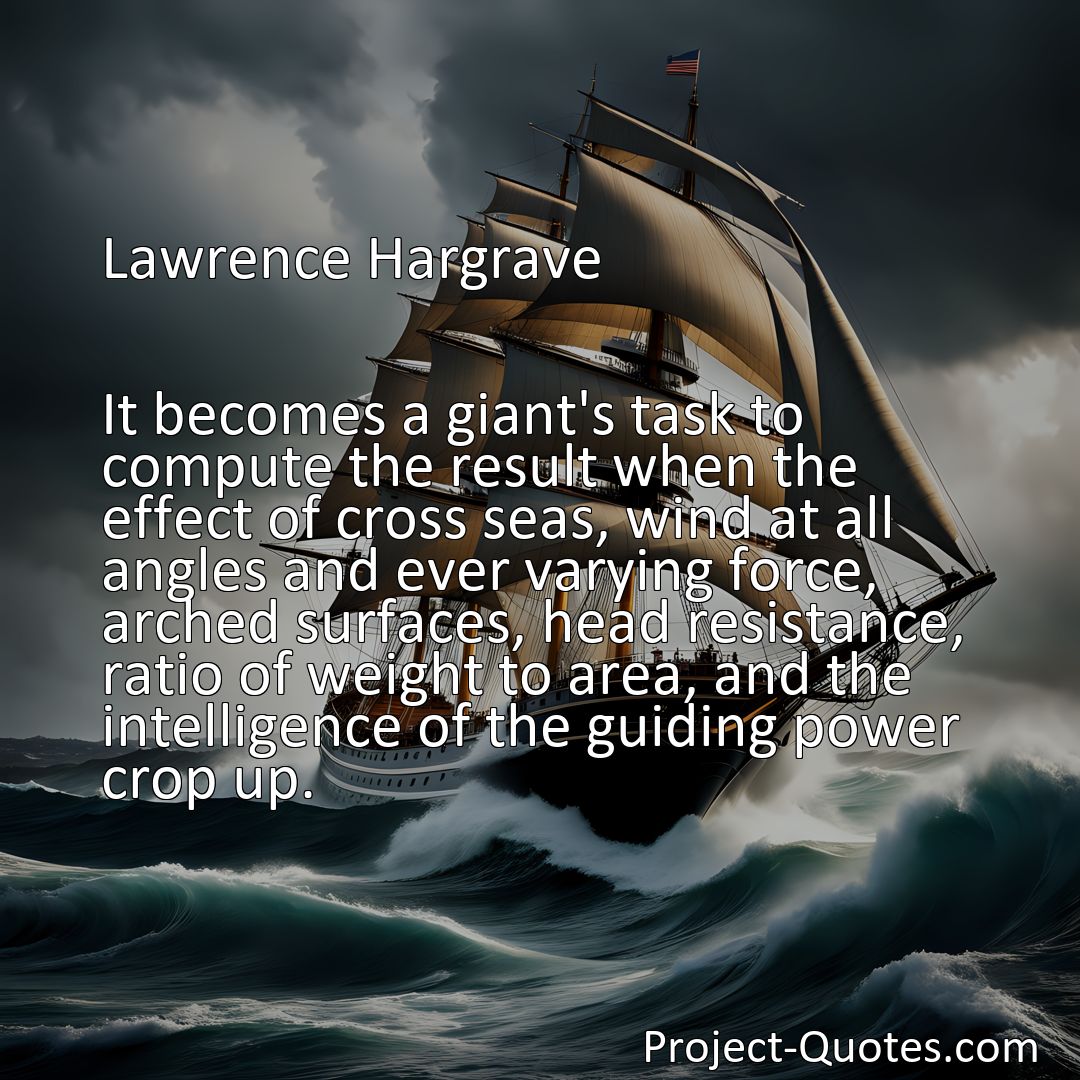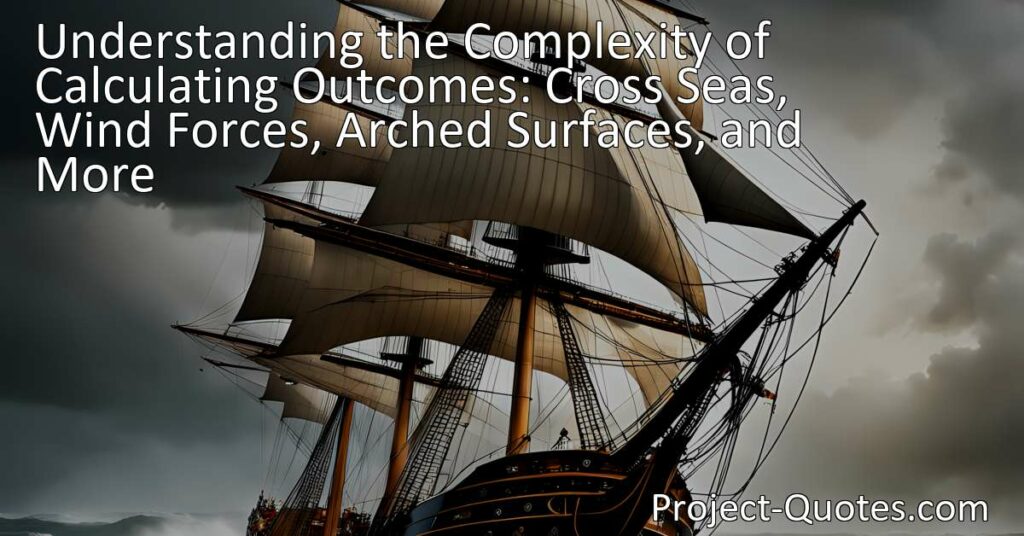It becomes a giant’s task to compute the result when the effect of cross seas, wind at all angles and ever varying force, arched surfaces, head resistance, ratio of weight to area, and the intelligence of the guiding power crop up.
Lawrence Hargrave
Understanding the Complexity of Calculating Outcomes: Cross Seas, Wind Forces, Arched Surfaces, and MoreHave you ever wondered how complicated it is to calculate the outcome when multiple factors come together? From cross seas to unpredictable wind forces, arched surfaces, and more, determining the result requires comprehensive analysis and understanding. Engineers, scientists, and experts in various fields engage in exhaustive simulations and calculations to navigate the complexities of these interactions.
Table of Contents
- 1 It becomes a giant’s task to compute the result when the effect of cross seas, wind at all angles and ever varying force, arched surfaces, head resistance, ratio of weight to area, and the intelligence of the guiding power crop up.
- 2 Lawrence Hargrave
- 3 Meaning of Quote – It becomes a giant’s task to compute the result when the effect of cross seas, wind at all angles and ever varying force, arched surfaces, head resistance, ratio of weight to area, and the intelligence of the guiding power crop up.
- 4 Freely Shareable Quote Image
- 5 Related
Meaning of Quote – It becomes a giant’s task to compute the result when the effect of cross seas, wind at all angles and ever varying force, arched surfaces, head resistance, ratio of weight to area, and the intelligence of the guiding power crop up.
Have you ever wondered how complicated it is to calculate the outcome of various factors coming together? According to the quote, it becomes a giant’s task to compute the result when considering influences like cross seas, wind from different directions and intensities, curved surfaces, resistance encountered, the ratio of weight to area, and the intelligence of the guiding power. Let’s dive deeper into these ideas to better understand the complexity and intricacies involved.
Cross seas refer to the phenomenon where two different wave systems intersect, often resulting in chaotic and unpredictable conditions at sea. When these cross seas interact with an object or vessel, such as a boat or a ship, the consequences can be challenging to determine. The waves’ directions, heights, and the interaction between them create a disorganized and turbulent environment that affects the movement and stability of the vessel.
Wind at all angles and ever varying force is another factor that adds to the complexity. Wind has a significant impact on any object’s movement, be it a flying kite, a sailing boat, or an aircraft. However, when the wind comes from multiple directions and fluctuates in strength, accurately predicting the effect on the object becomes even more challenging. The combination of different wind forces acting from various angles introduces a level of uncertainty regarding the outcome and requires a meticulous assessment.
Arched surfaces, like that of an airplane wing or a boat hull, add another layer of complexity to the calculations. These curved surfaces interact with the surrounding air or water, creating lift or reducing drag. The shape, curvature, and angles of these surfaces determine how efficiently they can navigate through their respective mediums. Achieving the optimal balance between lift and drag to ensure stability and performance requires careful consideration of these factors.
Head resistance, also known as drag, is another element that plays a crucial role in calculating outcomes. When an object moves through a fluid medium, such as air or water, it inevitably encounters resistance caused by the medium’s viscosity. This resistance slows down the object’s motion and affects its efficiency. Estimating the precise amount of resistance an object will face involves considering its shape, size, velocity, and the properties of the medium it is moving through.
The ratio of weight to area is yet another factor that complicates the overall calculation. Depending on an object’s weight and the area it interacts with the medium, its buoyancy, stability, and maneuverability can vary significantly. Objects with a higher weight-to-area ratio tend to sink or have limited mobility compared to those with a lower ratio. Calculating and understanding this ratio is crucial when determining an object’s behavior in different environmental conditions.
Lastly, the quote mentions the intelligence of the guiding power, which alludes to the control or guidance mechanism that influences the object’s trajectory or movement. This intelligence plays a vital role in adapting and responding to the various effects discussed earlier. For example, in the case of an aircraft, the intelligence lies in the pilot’s decision-making, adjustments to control surfaces, and the overall design and responsiveness of the aircraft’s control systems. The guiding power, whether human or artificial, must make informed choices based on the constantly changing conditions to ensure success.
When all these factors come together, the task of computing the outcome becomes colossal. Engineers, scientists, and experts in respective fields engage in exhaustive simulations, calculations, and experiments to understand and predict the behavior of objects in complex environments. Their goal is to minimize risks and enhance safety, whether it be in designing aircraft, ships, or any other object that interacts with natural forces.
Moreover, these calculations are not limited to the realm of engineering and science. They extend to numerous other fields where outcomes are influenced by multiple factors, such as economics, social sciences, and even everyday decision-making. In each case, the challenge lies in quantifying and comprehending the intricate interactions between the elements at play.
In conclusion, the quote emphasizes the daunting task of calculating the result when numerous factors come into play. Whether it is cross seas, unpredictable wind forces, arched surfaces, head resistance, weight-to-area ratios, or the intelligence of the guiding power, determining the outcome requires comprehensive analysis and understanding. The complexity involved in these calculations highlights the significance of expertise and careful consideration when dealing with the effects of multiple factors on any given situation. By recognizing and appreciating these intricacies, we can better comprehend and navigate the complexities of the world around us.
I hope this quote inspired image brings you hope and peace. Share it with someone who needs it today!


